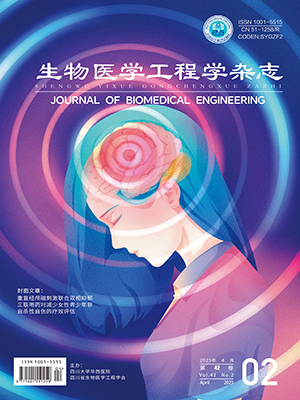| 1. |
王嘉津, 左国坤, 张佳楫, 等. 腕功能康复机器人按需辅助控制策略研究. 生物医学工程学杂志, 2020, 37(1): 129-135.
|
| 2. |
程洪, 黄瑞, 邱静, 等. 康复机器人及其临床应用综述. 机器人, 2021, 43(5): 606-619.
|
| 3. |
Afsar S I, Mirzayev I, Yemisci O U, et al. Virtual reality in upper extremity rehabilitation of stroke patients: a randomized controlled trial. J Stroke Cerebrovasc Dis, 2018, 27(12): 3473-3478.
|
| 4. |
Schaham N G, Zeilig G, Weingarden H, et al. Game analysis and clinical use of the Xbox-Kinect for stroke rehabilitation. Int J Rehabil Res, 2018, 41(4): 323-330.
|
| 5. |
Sanchez L, Courtine A, Gerard-Flavian G, et al. The use of a social assistive robot: NAO for post strokes rehabilitation therapy: a preliminary study. Comput Methods Biomech Biomed Eng, 2019, 22(Sup1): S478-S480.
|
| 6. |
Bakhti K K A, Laffont I, Muthalib M, et al. Kinect-based assessment of proximal arm non-use after a stroke. J Neuroeng Rehabil, 2018, 15(1): 1-12.
|
| 7. |
Semblantes P A, Andaluz V H, Lagla J, et al. Visual feedback framework for rehabilitation of stroke patients. Inform Med Unlocked, 2018, 13: 41-50.
|
| 8. |
Dubey V N, Manna S K. Design of a game-based rehabilitation system using kinect sensor// 2019 Design of Medical Devices Conference. Minneapolis: ASME, 2019: V001T03A005.
|
| 9. |
Cai L, Ma Y, Xiong S, et al. Validity and reliability of upper limb functional assessment using the microsoft Kinect V2 sensor. Appl Bionics Biomech, 2019, 2019: 7175240.
|
| 10. |
侯增广, 赵新刚, 程龙, 等. 康复机器人与智能辅助系统的研究进展. 自动化学报, 2016, 42(12): 1765-1779.
|
| 11. |
吴宏健, 李莉娜, 李龙, 等. 脑卒中后手功能康复机器人综合干预研究进展. 生物医学工程学杂志, 2019, 36(1): 151-156.
|
| 12. |
Yavşan E, Uçar A. Gesture imitation and recognition using Kinect sensor and extreme learning machines. Measurement, 2016, 94: 852-861.
|
| 13. |
Elbasiony R, Gomaa W. Humanoids skill learning based on real-time human motion imitation using Kinect. Intel Serv Robot, 2018, 11(2): 149-169.
|
| 14. |
Hu N, Zheng L. Human action imitation system based on NAO robot// 2019 IEEE 3rd Information Technology, Networking, Electronic and Automation Control Conference (ITNEC). Chengdu: IEEE, 2019: 2261-2264.
|
| 15. |
Wei Y, Zhao J. Designing human-like behaviors for anthropomorphic arm in humanoid robot NAO. Robotica, 2020, 38(7): 1205-1226.
|
| 16. |
黄玲涛, 王彬, 倪涛, 等. 基于Kinect的机器人抓取系统研究. 农业机械学报, 2019, 50(1): 390-399.
|
| 17. |
于建均, 门玉森, 阮晓钢, 等. 基于Kinect的NAO机器人动作模仿系统的研究与实现. 智能系统学报, 2016, 11(2): 180-187.
|
| 18. |
滑少扬. 基于Kinect的NAO机器人的模仿动作的研究. 秦皇岛: 燕山大学, 2017.
|
| 19. |
Zhang Z, Niu Y, Kong L, et al. A real-time upper-body robot imitation system. Int J Robot Control, 2019, 2(1): 49.
|
| 20. |
Wang Z, Liang R, Chen Z, et al. Fast and intuitive kinematics mapping for human-robot motion imitating: A virtual-joint-based approach. IFAC-PapersOnLine, 2020, 53(2): 10011-10018.
|
| 21. |
Assad-Uz-Zaman M, Islam M R, Rahman M H, et al. Kinect controlled NAO robot for telerehabilitation. J Intell Syst, 2020, 30(1): 224-239.
|
| 22. |
Assad-Uz-Zaman M, Islam M R, Rahman M H, et al. Robot sensor system for supervised rehabilitation with real-time feedback. Multimed Tools Appl, 2020, 79(3): 26643-26660.
|
| 23. |
冷舒, 吴克, 居鹤华. 机械臂运动学建模及解算方法综述. 宇航学报, 2019, 40(11): 1262-1273.
|
| 24. |
马丛俊, 赵涛, 向国菲, 等. 基于逆运动学的柔性机械臂末端定位控制. 机械工程学报, 2021, 57(13): 163-171.
|
| 25. |
Zhang T, Song Y, Wu H, et al. A novel method to identify DH parameters of the rigid serial-link robot based on a geometry model. Ind Robot, 2020, 48(1): 157-167.
|
| 26. |
Liu X, Qiu C, Zeng Q, et al. Kinematics analysis and trajectory planning of collaborative welding robot with multiple manipulators. Procedia CIRP, 2019, 81: 1034-1039.
|
| 27. |
Alam M M, Ibaraki S, Fukuda K. Kinematic modeling of six-axis industrial robot and its parameter identification: a tutorial. Int J Auto Tech-Kor, 2021, 15(5): 599-610.
|
| 28. |
Xu N, Peng X, Peng L, et al. Modeling and kinematics analysis of a novel 5-DOF upper limb exoskeleton rehabilitation robot// 2020 39th Chinese Control Conference (CCC). Shenyang: IEEE, 2020: 1052-1057.
|
| 29. |
Guo F, Cai H, Ceccarelli M, et al. Enhanced D-H: an improved convention for establishing a robot link coordinate system fixed on the joint. Ind Robot, 2019, 47(2): 197-205.
|
| 30. |
Guida R, De Simone M C, Dašić P, et al. Modeling techniques for kinematic analysis of a six-axis robotic arm// IOP Conference Series: Materials Science and Engineering. Wuhan: IOP, 2019, 568(1): 012115.
|
| 31. |
胡奎, 张继文, 董云飞, 等. 针对关节限位优化的7自由度机械臂逆运动学解法. 清华大学学报(自然科学版), 2020, 60(12): 1007-1015.
|
| 32. |
周书华, 张文辉, 闻志, 等. 直角坐标机器人基于D-H参数的运动学建模与轨迹规划. 电工技术, 2020(24): 78-80, 83.
|
| 33. |
Tölgyessy M, Dekan M, Chovanec Ľ, et al. Evaluation of the azure Kinect and its comparison to Kinect V1 and Kinect V2. Sensors, 2021, 21(2): 413.
|
| 34. |
Assad-Uz-Zaman M, Islam M R, Rahman M H. Upper-extremity rehabilitation with NAO robot// 5th International Conference of Control, Dynamic Systems, and Robotics. Niagara Falls: CDSR, 2018: 117.
|
| 35. |
刘晓光, 李梦楠, 王立玲, 等. 基于表面肌电信号的康复过程中肌疲劳有效性分析. 生物医学工程学杂志, 2019, 36(1): 80-84.
|




